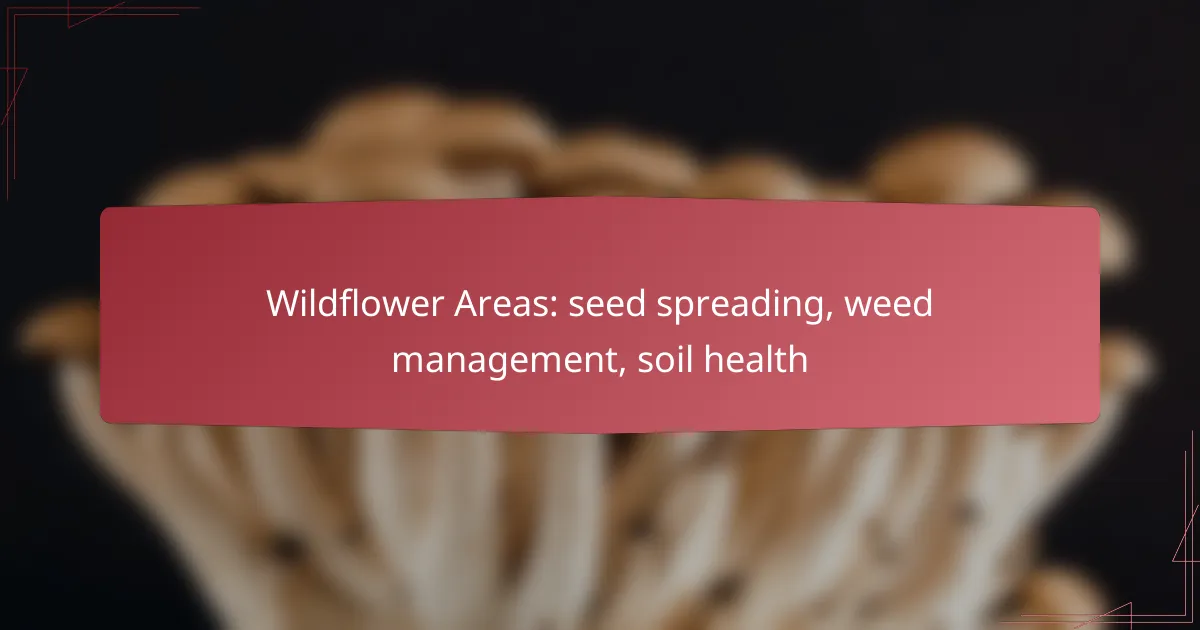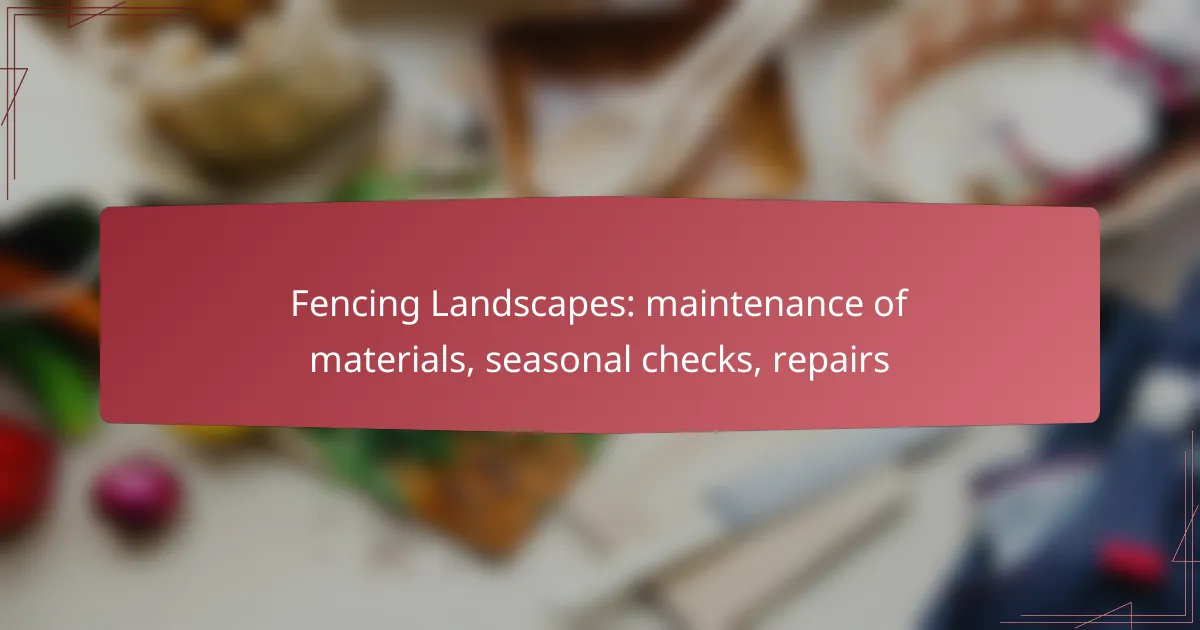Creating vibrant wildflower areas requires careful attention to seed spreading, weed management, and soil health. Employing effective seed distribution methods ensures successful germination, while proactive weed management techniques help protect native flora from invasive species. Additionally, maintaining healthy soil is essential for supporting diverse plant life and fostering resilient ecosystems.

How to effectively spread wildflower seeds in urban areas?
To effectively spread wildflower seeds in urban areas, consider using methods that ensure even distribution and optimal germination. Techniques such as broadcasting and using seeders can help achieve a successful wildflower planting.
Best techniques for seed spreading
Broadcasting is a common technique where seeds are scattered evenly over the soil surface. This method works well for larger areas but requires careful calibration to avoid overcrowding. Alternatively, using a seed drill or a hand-held seeder can provide more precise placement, especially in smaller or more controlled environments.
Another effective method is the use of seed mats, which are pre-seeded biodegradable sheets that can be laid directly onto the soil. This technique simplifies the process and helps retain moisture, promoting better seed germination.
Optimal timing for seed dispersal
The best time to spread wildflower seeds in urban areas is typically in the early spring or fall. Spring sowing allows seeds to germinate with the warming temperatures, while fall sowing takes advantage of natural stratification during winter. Aim for a window when soil temperatures are consistently above 10°C (50°F) for spring and below 15°C (59°F) for fall.
Consider local climate conditions when timing your seed dispersal. In warmer regions, late winter or early spring may be ideal, while cooler areas might benefit from a late summer sowing to prepare for fall germination.
Recommended seed types for urban environments
When selecting wildflower seeds for urban areas, choose native species that are well-adapted to local conditions. Popular options include Black-eyed Susan, Coneflower, and Butterfly Weed, which attract pollinators and thrive in various soil types.
Mixes specifically designed for urban settings often include drought-tolerant and low-maintenance varieties. Look for seed packets labeled as “urban wildflower mix” to ensure compatibility with city environments and reduced competition from invasive species.
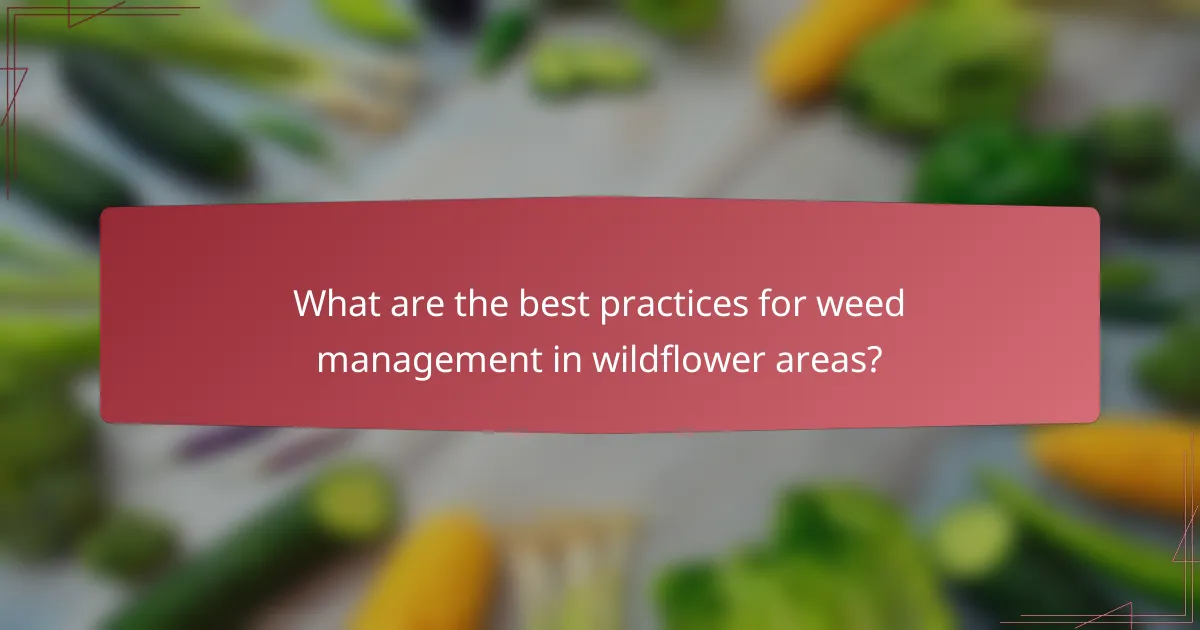
What are the best practices for weed management in wildflower areas?
Effective weed management in wildflower areas involves a combination of preventive measures, organic techniques, and appropriate tools. By focusing on these best practices, you can promote healthy wildflower growth while minimizing the impact of invasive species.
Preventive measures for weed control
Preventive measures are crucial for controlling weeds before they establish themselves. Start by selecting native wildflower species that are well-adapted to your local environment, as they can outcompete many invasive weeds. Additionally, maintaining healthy soil through proper nutrient management and mulching can create an unfavorable environment for weed germination.
Regular monitoring of your wildflower area is essential. Early identification of weed species allows for timely intervention, preventing them from spreading. Consider implementing a rotation system for planting to disrupt the life cycles of persistent weeds.
Organic weed management techniques
Organic weed management techniques focus on natural methods to control unwanted plants. Hand-pulling is an effective strategy for small infestations, especially when done before weeds set seed. For larger areas, consider using flame weeding or boiling water to kill weeds without chemicals.
Another effective organic method is the use of cover crops. These plants can suppress weed growth by outcompeting them for resources and light. When selecting cover crops, choose species that complement your wildflower planting and enhance soil health.
Tools for effective weed removal
Using the right tools can significantly improve your weed removal efforts. Hand tools like hoes, trowels, and weeding forks are ideal for small areas and precision work. For larger plots, consider using a hoe with a long handle or a garden cultivator to cover more ground efficiently.
For persistent weeds, a weed torch can provide an effective solution by applying heat directly to the plants. Always follow safety guidelines when using such tools, especially in dry areas where fire hazards may be a concern. Regular maintenance of your tools will ensure they remain effective and safe to use.
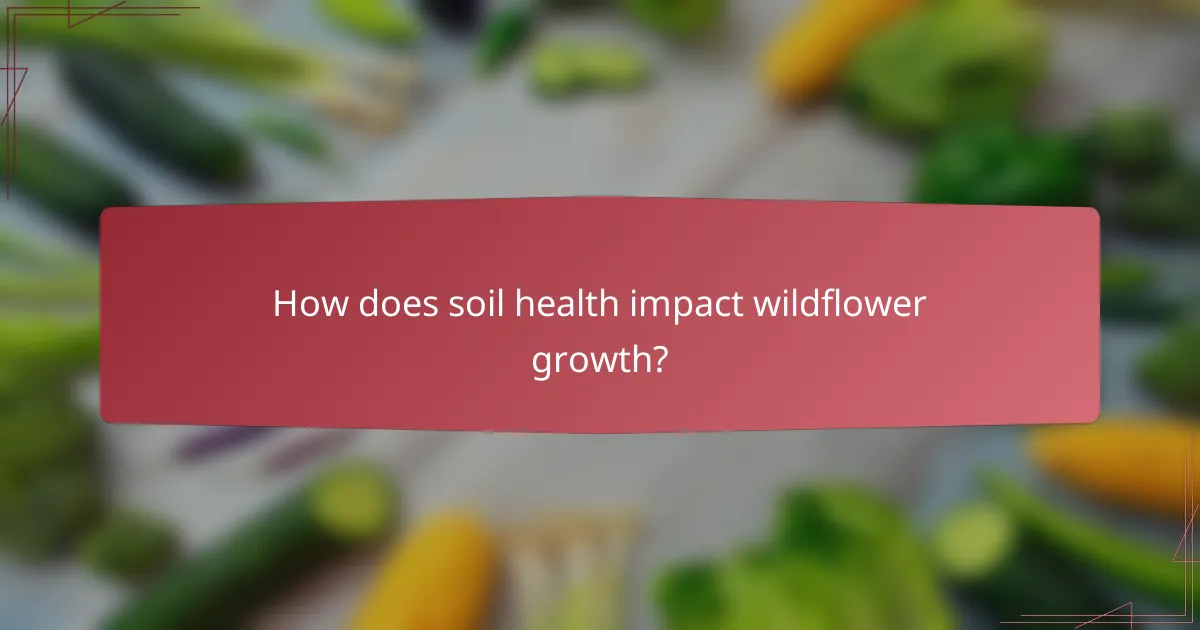
How does soil health impact wildflower growth?
Soil health is crucial for wildflower growth as it affects nutrient availability, water retention, and microbial activity. Healthy soil supports diverse plant life, enhances resilience against pests, and promotes vibrant ecosystems.
Key soil health indicators
Key indicators of soil health include organic matter content, pH levels, and microbial biomass. High organic matter improves soil structure and moisture retention, while pH affects nutrient availability. Regular monitoring of these indicators helps assess soil vitality.
Additionally, the presence of earthworms and other beneficial organisms indicates a healthy soil ecosystem. A balanced ratio of sand, silt, and clay also contributes to optimal wildflower growth.
Soil amendments for wildflower areas
To enhance soil health in wildflower areas, consider using organic amendments such as compost, aged manure, or mulch. These materials improve nutrient content and soil structure, promoting better plant growth.
In some cases, adding lime can help adjust soil pH to optimal levels for wildflowers, typically between 6.0 and 7.5. Avoid synthetic fertilizers, as they can disrupt soil microbial communities and lead to imbalances.
Testing soil health in local gardens
Testing soil health in local gardens can be done through DIY kits or professional services. Home testing kits typically measure pH, nutrient levels, and organic matter content, providing a snapshot of soil conditions.
For more comprehensive analysis, consider sending samples to a local agricultural extension service. They can offer tailored recommendations based on specific soil conditions and local wildflower species.
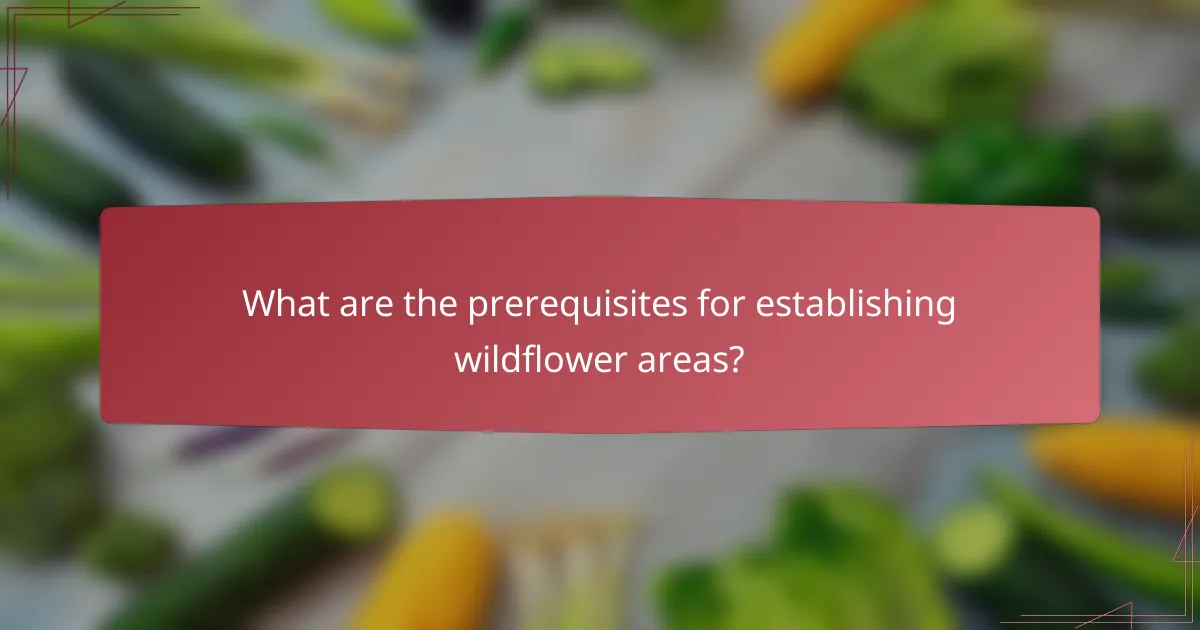
What are the prerequisites for establishing wildflower areas?
To establish wildflower areas, it is essential to consider site selection, environmental factors, and soil health. These elements ensure that the wildflowers thrive and contribute positively to the ecosystem.
Site selection criteria
Choosing the right site is crucial for the success of wildflower areas. Look for locations with adequate sunlight, good drainage, and minimal competition from invasive species. Areas with sandy or loamy soil are often ideal, as they provide the necessary nutrients and support for wildflower growth.
Evaluate the existing vegetation and land use. Sites that have been previously disturbed or are underutilized can be excellent candidates for wildflower establishment. Avoid areas with heavy foot traffic or frequent maintenance, as these can hinder the growth of wildflowers.
Environmental considerations
Environmental factors play a significant role in the establishment of wildflower areas. Assess the local climate, including temperature ranges and rainfall patterns, to ensure selected wildflower species are suited to the conditions. Native species are often more resilient and better adapted to local environments.
Consider the surrounding ecosystem, including pollinator populations and other wildlife. Creating a habitat that supports bees, butterflies, and other pollinators can enhance the success of wildflower areas. Additionally, ensure that the site does not disrupt existing habitats or contribute to soil erosion.
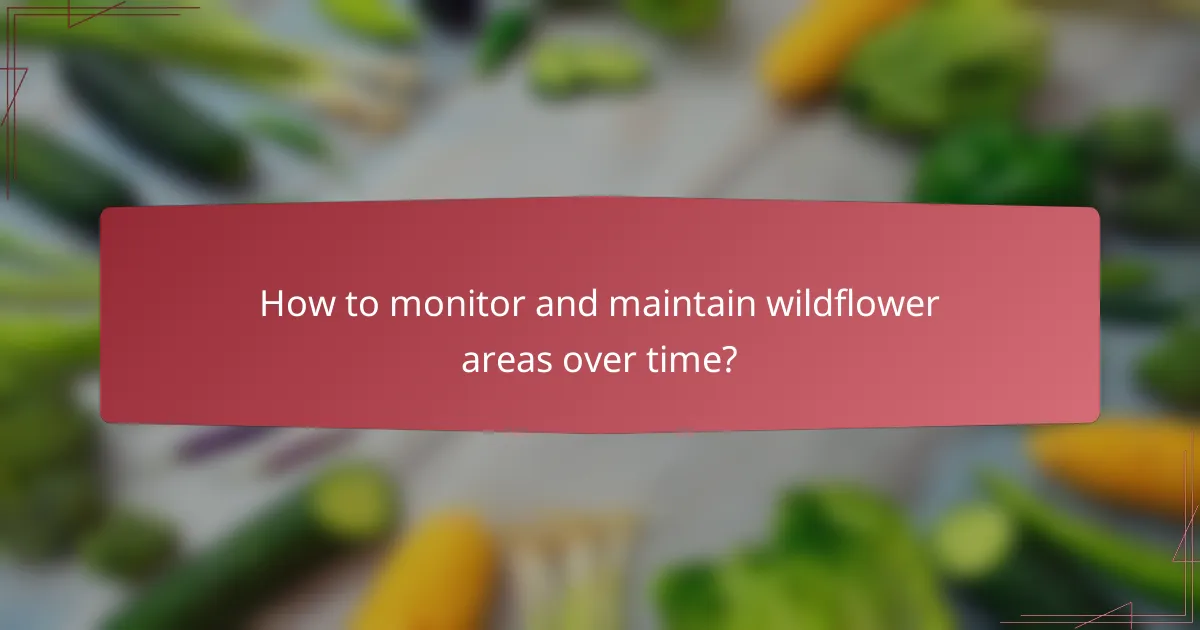
How to monitor and maintain wildflower areas over time?
Monitoring and maintaining wildflower areas involves regular assessments and interventions to ensure plant health, diversity, and soil quality. Key practices include establishing maintenance schedules and monitoring plant health to promote a thriving ecosystem.
Regular maintenance schedules
Establishing a regular maintenance schedule is crucial for the longevity of wildflower areas. This typically includes seasonal tasks such as mowing, weeding, and soil testing to maintain optimal growing conditions. Aim for maintenance at least two to four times a year, depending on local climate and plant growth rates.
During maintenance, prioritize tasks like removing invasive species and controlling weeds to prevent them from outcompeting native wildflowers. Consider using organic herbicides or manual removal methods to minimize environmental impact.
Monitoring plant health and diversity
Monitoring plant health and diversity is essential for assessing the success of wildflower areas. Regularly check for signs of disease, pests, and overall plant vigor. A diverse plant community not only enhances aesthetic appeal but also supports local wildlife, so aim for a mix of native species.
Conduct plant surveys at least once a year to document species presence and abundance. Use simple metrics, such as species richness (the number of different species) and evenness (how evenly individuals are distributed among species), to evaluate diversity. This data can inform future management decisions and help identify areas needing attention.
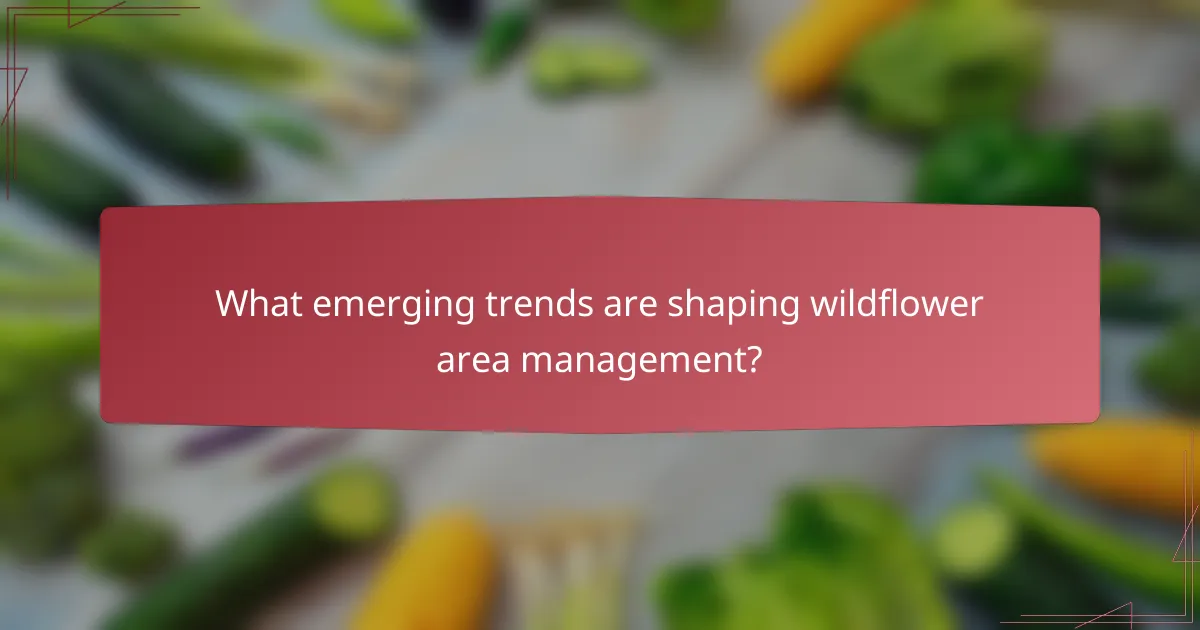
What emerging trends are shaping wildflower area management?
Emerging trends in wildflower area management focus on enhancing biodiversity, improving soil health, and fostering community involvement. These trends emphasize innovative practices and technologies that support sustainable ecosystems while addressing challenges like weed management and seed dispersal.
Community engagement in wildflower projects
Community engagement is crucial for the success of wildflower projects, as it fosters a sense of ownership and responsibility among local residents. Involving community members in planning and maintenance can lead to better outcomes, as they often have valuable insights into local conditions and preferences.
Workshops, volunteer days, and educational programs can help raise awareness about the benefits of wildflower areas. These initiatives encourage participation and can significantly enhance the effectiveness of planting and maintenance efforts.
Innovations in seed technology
Innovations in seed technology are transforming wildflower area management by improving seed viability and dispersal methods. Techniques such as seed coating and the development of native seed mixes can enhance germination rates and resilience against local pests and diseases.
Additionally, advances in precision agriculture allow for targeted seed application, reducing waste and increasing the success rate of wildflower establishment. Utilizing these technologies can lead to more efficient use of resources and better outcomes for biodiversity in wildflower areas.
